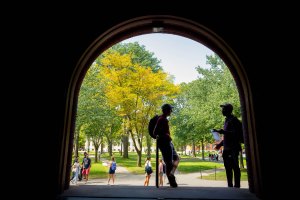Tag: Faculty of Arts and Sciences
-
Campus & Community
Investigating phenomenon of sleep
Alexander Schier’s transparent fish are helping him understand the basic secrets of human development: how early embryonic cells communicate so that some develop into heart tissue, some into brain cells, and others into tissues that form the rest of the body.
-
Campus & Community
Green Campus contest puts wind in energy’s sails
The Harvard Green Campus Initiative is giving Harvard students and staff the chance to turn their energy conservation habits – or their new resolutions to conserve – into clean wind…
-
Science & Tech
Space telescope captures cosmic ‘Mountains of Creation’
Captured by the Spitzer Space Telescope’s infrared eyes, a new majestic image resembles the iconic “Pillars of Creation” picture taken of the Eagle Nebula in visible light by NASA’s Hubble…
-
Science & Tech
Cosmic cloudshine
Hubble’s iconic images include many shots of cosmic clouds of gas and dust called nebulae. For example, the famous “Pillars of Creation” mark the birthplace of new stars within the…
-
Campus & Community
Armenia’s remarkable alphabet
Armenians pride themselves on being the first nation to adopt Christianity, an event that is supposed to have occurred in the early fourth century when St. Gregory the Illuminator succeeded…
-
Health
Sublethal force: New antibiotic aims to tame bacterial toxins
Using an innovative screening approach, researchers in the lab of John Mekalanos have identified an entirely new class of antibiotics active against the cholera bacterium. While traditional antibiotics kill bacteria…
-
Campus & Community
Wing color not just for looks
Harvard and Russian researchers have documented natural selection’s role in the creation of new species through a process called reinforcement, where butterfly wing colors differ enough to avoid confusion with…
-
Campus & Community
A tale of a venomous dispute
Sea spiders as large as a foot across have been seen crawling along the deep ocean floor from the windows of submersible research vessels. Most of them, however, including those in a Harvard study, are a scant millimeter (.04 inch) in size. But big or small, they boast long snouts, on either side of which…
-
Health
Zoologist says in animal kingdom, less is more
Harvard researcher Piotr Naskrecki hopes his new book, “The Smaller Majority” (Harvard University Press, 2005), will win over some new advocates for the tiny creatures he has spent his life…
-
Health
Stroke patients with mild symptoms may still need clot- dissolving drug
“Our primary finding was that about 30 percent of those patients judged ‘too good to treat’ either died or were discharged to a rehabilitation facility,” says Eric Smith, MD, FRCPC,…
-
Campus & Community
Climate choices: Grim and grimmer
Climate change from burning fossil fuels is probably already unavoidable, but it is still up to humans to decide just how bad it will be, Professor of Earth and Planetary…
-
Health
How ant (and human) societies might grow
Pellegrino University Professor Emeritus Edward O. Wilson remains fascinated with the highly organized societies of ants, bees, wasps, termites, and humans. He and Bert Holldobler, with whom he shared a…
-
Campus & Community
Alien abduction claims explained
Abduction stories are strikingly similar. Victims wake up and find themselves paralyzed, unable to move or cry out for help.
-
Science & Tech
Ferreting out the first stars
The first stars are so distant and formed so long ago that they are invisible to our best telescopes. Until they explode. Hypernovas (more powerful cousins of supernovas) and their…
-
Science & Tech
Fastest pulsar speeding out of galaxy
A speeding, superdense neutron star somehow got a powerful “kick” that is propelling it completely out of our Milky Way Galaxy into the cold vastness of intergalactic space. Its discovery…
-
Science & Tech
How to build a big star
The most massive stars in our galaxy weigh as much as 100 small stars like the Sun. How do such monsters form? Do they grow rapidly by swallowing smaller protostars…
-
Campus & Community
Adult cells transformed into stem cells
Harvard researchers fused adult skin cells with embryonic stem cells in such a way that the genes of the embryonic cells reset the genetic clock of the adult cells, turning…
-
Health
Size of brain structure could signal vulnerability to anxiety disorders
Individuals respond with physical and emotional distress to situations that recall traumatic memories. Such responses usually diminish gradually, as those situations are repeated without unpleasant occurrences; this is called “extinction…
-
Campus & Community
Suicides are down, researchers say
The suicide rate among men and women ages 18 to 54 years fell 6 percent since 1990. In 1990-92, the rate was approximately 15 out of every 100,000 adults. It…
-
Science & Tech
Amateur and professional astronomers team to find new planet
Astronomer Scott Gaudi of the Harvard-Smithsonian Center for Astrophysics believes that microlensing has the potential for wide use in the future: “With improving technologies and techniques, the first Earth-sized planet…
-
Campus & Community
Kudzu cuts alcohol consumption
Scott Lukas, professor of psychiatry at McLean, a psychiatric hospital affiliated with Harvard Medical School, says these results inspired his team to test on humans. The study was conducted on…
-
Campus & Community
Social determinants key in who gets good care
Kerala is one of the poorer states in India, and yet it enjoys India’s highest life expectancy and lowest infant mortality rates. This seeming anomaly has caused many to wonder…
-
Science & Tech
Robotic telescope penetrates heart of universe’s most powerful explosion
Cullen Blake, a graduate student at the Harvard-Smithsonian Center for Astrophysics and lead author on the paper, said that the simultaneous observation of infrared light with a gamma-ray burst was…
-
Health
T cell misfits may spell autoimmunity
For a would-be T cell, the journey from cradle to grave is likely to be brief. After leaving the bone marrow, the immature immune cell travels directly to the thymus,…
-
Science & Tech
Student makes cableless cable
Matthew DePetro ’05 earned top honors for his senior design project, “Wireless Cable Television.” The first-prize entry “untethers” standard cable TV and even eliminates the need for a wall outlet.…
-
Campus & Community
Lazy eyes aid artists, biologist says
Margaret Livingstone found herself in a small room at the Louvre museum in Paris with four self-portraits by Rembrandt. She noticed something strange. The eyes of the great 17th century…
-
Campus & Community
Scientists create high-speed nanowire circuits
Chemists and engineers at Harvard University have made robust circuits from minuscule nanowires that align themselves on a chip of glass during low-temperature fabrication, creating rudimentary electronic devices that offer…


